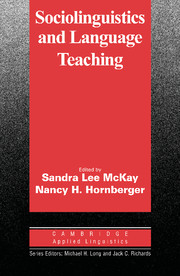Book contents
7 - Language and gender
Published online by Cambridge University Press: 22 July 2009
Summary
Introduction
In the United States during the late 1960s and early 1970s, women began to examine and critique societal practices that supported gender discrimination in consciousness-raising groups, in feminist cells, in rallies and media events (see Echols, 1989, for a history of the women's movement in the United States). In the academy, women and a few sympathetic men started to examine the practices and methods of their disciplines, subjecting them to similar critique for similar ends: the elimination of societal inequities based upon gender. The study of language and gender was initiated in 1975 by three books, the latter two of which have continued to significantly influence sociolinguistic work: Male/Female Language (Mary Ritchie Key), Language and Women's Place (Robin Lakoff), and Language and Sex: Difference and Dominance (Barrie Thorne and Nancy Henley, Eds.). The study of language and gender, then, like sociolinguistics in general (see Rickford, this volume), has always been grounded in eliminating disadvantage. Nonetheless, it has not always been immediately clear which strategy to adopt in doing so. As Riley writes, “both a concentration on and a refusal of the identity of ‘women’ are essential to feminism” (1988, p. 1). Like antiracist scholars, antisexist scholars must sometimes challenge false assumptions about both difference and similarity that result in discrimination. Overly dichotomous ideas of gender pervade Western society in ways that must be challenged.
- Type
- Chapter
- Information
- Sociolinguistics and Language Teaching , pp. 218 - 280Publisher: Cambridge University PressPrint publication year: 1995
- 11
- Cited by



